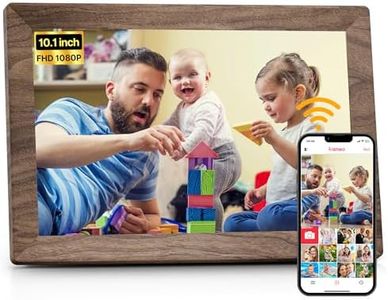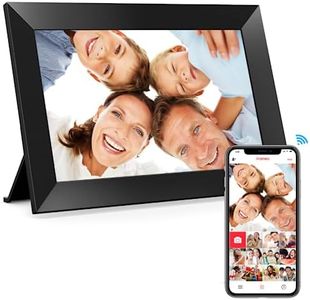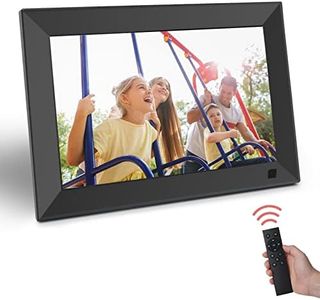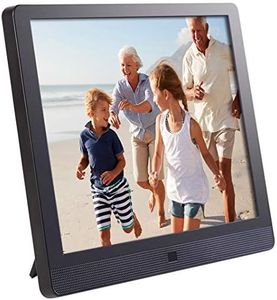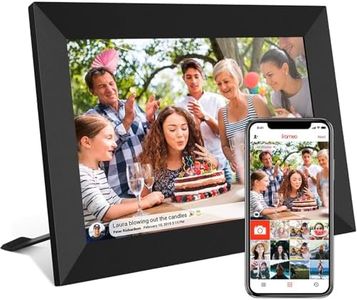We Use CookiesWe use cookies to enhance the security, performance,
functionality and for analytical and promotional activities. By continuing to browse this site you
are agreeing to our privacy policy
10 Best Digital Picture Frames
From leading brands and best sellers available on the web.Buying Guide for the Best Digital Picture Frames
Digital picture frames are a wonderful way to display your favorite photos without the hassle of printing and swapping out traditional pictures. Picking the right digital picture frame means considering your lifestyle, how you'll use it, and where it will be placed. To choose the best fit, focus on the most important features that impact usability, appearance, and maintenance. Understanding each specification will empower you to select a frame that matches your needs and provides an enjoyable photo-viewing experience.Screen SizeScreen size refers to the diagonal measurement of the frame's display, usually in inches. This spec is important because it determines how large your photos appear, and how much space the frame will take on your table or wall. Smaller sizes (7-8 inches) are suited for desks, nightstands, or crowded shelves, while medium (10-12 inches) can strike a good balance for general home use, and larger frames (15 inches and up) work best as statement pieces in living rooms or on walls. Think about where you want to display the frame and how far away people will typically view it. If space is limited, a smaller frame makes sense, but if you want your photos to catch everyone’s eye, a larger screen is ideal.
Screen ResolutionScreen resolution determines the clarity and detail of your photos, expressed in pixels (like 1280x800 or 1920x1080). Higher resolution means sharper and more vibrant images, which is especially important for larger screens where individual pixels could be more noticeable. Lower resolution screens can look fine for small frames or viewing at a distance, but for larger sizes or up-close viewing, a higher resolution (Full HD or higher) is preferable. Choose a resolution based on your expectations for image quality and how discernible you want details to be.
Photo Formats and CompatibilityThis describes which file types (like JPG, PNG, BMP) the frame can display, as well as compatibility with various storage methods (USB, SD card, cloud services). It's essential because if your frame doesn't support your photo files or the way you store them, you won't be able to use it easily. Most frames work with common formats, but if you have photos in unusual formats or want to use cloud storage or Wi-Fi, make sure the frame supports them. Think about how you store and transfer photos now, and pick a frame that accommodates your habits.
Connectivity (Wi-Fi, USB, SD Card)Connectivity refers to how you get your photos onto the frame. Some frames use USB drives or SD cards, while many modern ones offer Wi-Fi for wireless uploads or even allow friends and family to send photos directly to your frame from anywhere. If you want simplicity and don’t update photos often, a USB or SD card might be enough. However, if you enjoy changing photos regularly or want to manage your frame remotely, choose one with Wi-Fi or cloud app features. Your preference for convenience and tech-savviness should guide this decision.
User Interface and ControlsThis spec covers how you interact with the frame, whether it’s through buttons, a touchscreen, or a remote control. A simple, intuitive interface makes it easy to manage your photos and settings, which is important if you plan to adjust the frame often or if less tech-savvy people will use it. Touch screens are convenient for direct interaction, but traditional buttons or remotes might suit people who prefer physical controls. Consider who will use the frame most and choose an interface that matches their comfort level.
Design and Build QualityThe look and feel of the frame, including the materials used and how well it’s constructed, are important for blending with your home decor. Some frames mimic traditional wood or metal, while others use simple plastics. A sturdy build ensures longevity and often feels more premium. Select a design that matches your style and a build quality that will last in your intended space.
Additional Features (Slideshow, Clock, Calendar, Motion Sensor)Many digital frames offer extra features like slideshow modes, clocks, calendars, motion sensors to turn on the display when you’re nearby, or speakers for video and music playback. These can enhance the frame’s usefulness beyond just showing pictures. If you want a multifunctional display, look for these extras, but if you prefer simplicity, basic photo display models may be just right. Your desired balance between features and simplicity will help you decide.


